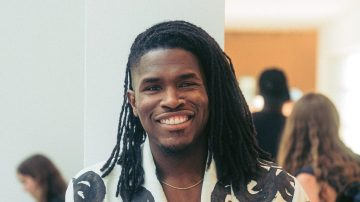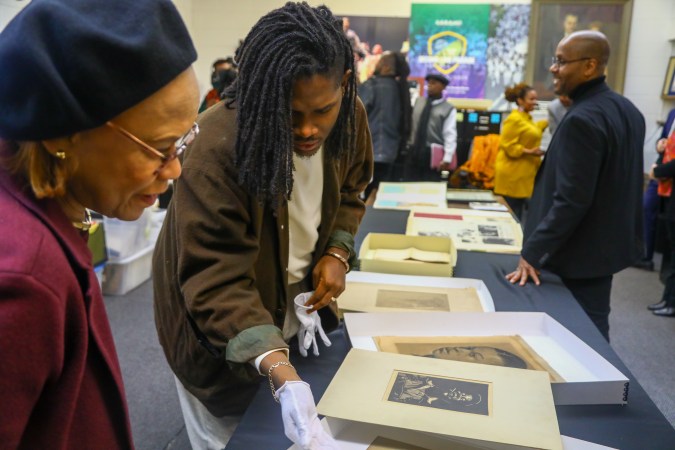From Hampton University To The NMAAHC: Dr. Teddy Reeves On Faith, Mentorship, And Curating Culture
Long before he became the Curator of Religion at the Smithsonian’s National Museum of African American History and Culture (NMAAHC), Dr

Long before he became the Curator of Religion at the Smithsonian’s National Museum of African American History and Culture (NMAAHC), Dr. Teddy Reeves was a self-proclaimed “Black boy from the South” with dreams of becoming the next Bryant Gumbel. His path to one of the nation’s most prestigious cultural institutions began not at his first-choice school, but at Hampton University, a place he’d never even visited before enrolling.
“I always knew that I wanted to go to an HBCU. I am third generation,” Reeves told OffTheYard. “My grandmother went to Winston-Salem Teachers College, my mother went to Winston-Salem State University. I grew up in Winston-Salem, North Carolina around HBCUs with Winston there, and (North Carolina) A&T minutes down the road, it was always a part of culture. It was a part of understanding of who I was, my identity.”
When senior year rolled around, Reeves applied to Morehouse College. “Morehouse was my first choice,” he said, but he received a rejection letter. A few days later, however, a different envelope arrived. “I got my acceptance letter from Hampton that same week,” he recalled. “I had never visited Hampton’s campus. I just knew of it through a guidance counselor and a chemistry teacher who were alums. They kept saying, ‘Hampton’s going to be perfect for you.’”
Reeves laughed as he remembered the twist of fate.
“Then, after my mom paid the non-refundable deposit, Morehouse sent a second letter saying they had sent the wrong letter to the wrong person, but I was already on my way to Hampton.”
That decision, though initially unexpected, turned out to be transformative.
Reeves entered Hampton as a journalism major—no surprise for a young man who had attended a high school dedicated to media, but by his junior year, he had switched to English, drawn to the literature courses that had long been his favorite. The true magic of Hampton, he said, was what happened outside the classroom.
“I was an RA, president of the Pre-Alumni Council, I ran Miss Hampton’s pageant, started the Mr. James Hall pageant, was a peer counselor, ran Hampton’s fashion show, started World AIDS Day,” he rattled off to OffTheYard. “Hampton was the space for me to fall and explore safely.”

That safe space, he emphasized, wasn’t just social, it was deeply personal and developmental.
“It offered me the opportunity to try new things, to figure out what worked for me as I was developing into the man I am today.”
At Hampton, he learned that leadership didn’t have to come in the form of sports or tradition, it could emerge through creativity, service, and community building.
“I didn’t play sports,” Reeves noted. “But it offered me an opportunity to exercise leadership in organizational development. It offered me the opportunity to play with fashion and style. It afforded me a space to try new things, to try new experiences, to figure out what worked for me as I was developing into the man I am today.”
Reeves speaks with reverence when recalling the faculty who shaped this journey to manhood, figures like the late Dr. Sharon Simmons, Shonda Buchanan, and Dr. Lloren Foster. Simmons, his academic advisor, became a maternal figure.
“She provided a safe landing space,” he told OffTheYard. “For a student like me; raised by a single mother, coming into a place where many classmates were from higher socioeconomic backgrounds—she helped me feel welcomed and affirmed.”
But it was Dr. Foster, an English professor, who left the most indelible mark and he detailed a pivotal experience he had with him to OffTheYard.
“He would dig in my a**,” Reeves recalled with a laugh noting that he did a rush job on the final 15 pages of the 30 page project. “It was senior year, I running the Miss Hampton Pageant, I was running the fashion show, I was running for Mr. Pirate…”
Foster was unimpressed. “He called me into his office, closed the door, and went off on me. He literally ripped up the pages in front of me and said, ‘You have until Sunday at 8 a.m. to rewrite it.’”
With help from a classmate, Reeves stayed up for two nights straight, rereading books, dictating sections, and pushing himself and he was prepared to meet Foster face to face to turn in his work. That meeting never happened.
“He didn’t even show up Sunday morning. He sent one of the Omegas to pick it up,” Reeves laughed. “But I remember at my senior defense, he said, ‘I’m extremely proud of you.’ That calling from Black man to burgeoning Black man was to say, I see you and you’re living up to your potential. I went on to be an English teacher for two years after that and I credit him and Shonda (Buchanan) for for grounding me for creating space for me to explore in writing.”
That moment of affirmation marked not just the end of one chapter, but the quiet beginning of Reeves’ evolution as both a thinker and a creative.
Creativity is something Reeves knows well as he continues to find new ways to blend scholarship and storytelling in ways that resonate far beyond academia. One of his most impactful projects is godTalk, a digital series and traveling exhibit exploring how Black millennials engage with spirituality.

“It’s an exploration of how Black people, particularly Black millennials, are creating new languages for faith,” he said. “We’re using yoga, meditation, ancestral reverence, ways our grandparents might not recognize as ‘religion,’ but are deeply spiritual.”
Reeves sees godTalk not as a blueprint for religion, but as a tribute to its transformation over time.
“My goal was to provide a platform that says, ‘Your faith journey is valid, even if it doesn’t look like what you were taught. That has been the beauty of the work, that I am called to tell the stories of African -American religious and spiritual life through film, through art, and talk about the breadth of it, from Islam to Judaism to Ifa to Buddhism to Christianity and talk about the breadth and the ways that those experiences manifest themselves in life. And so it’s not a journey I could have anticipated. But the journey has been beautiful nonetheless.”
Reeves credits Hampton for preparing him for that journey, and the most profound lesson the waterside institution taught him surrounds the concept of “excellence,” fitting since the HBCU’s motto is “The Standard of Excellence, An Education for Life.”
“As a millennial now in midlife, I can nuance this idea of ‘excellence,’” he said. “Sometimes excellence is a trap for Black bodies—it demands a level that isn’t always helpful. But I’ve learned that excellence means bringing the best of what Teddy can offer in each moment. It’s not perfection. It’s about being of service to your community, your humanity and to yourself.”
Ultimately, Dr. Teddy Reeves remains a leading voice on religion and spirituality within African American history. At the NMAAHC, he helps shape exhibitions and conversations around Black religious life, cultural identity, and healing.
Still, when asked to reflect on his journey, he doesn’t start with his title or his accomplishments. He starts at Hampton.
“I always said my Hampton experience far supersedes those experiences at PWIs,” he told OffTheYard. “They had their own benefits, their own communities and experiences but it was nothing like being surrounded by people who look like me. People who had some of the same experiences, but some very different. And also being around folks who were moving upward, that we were all walking and running and sprinting and jogging in the same directions. That was affirming.” He continued, “It was affirming in myself. It was affirming in my spirit and my soul to be in that space. And I wouldn’t change a thing from that journey.”



